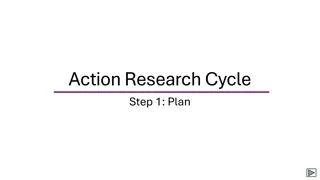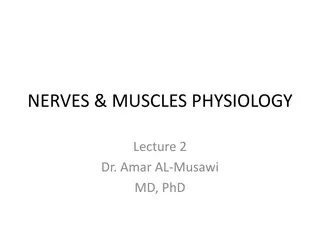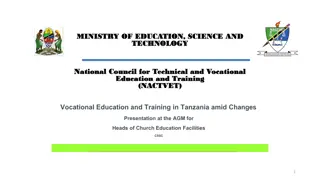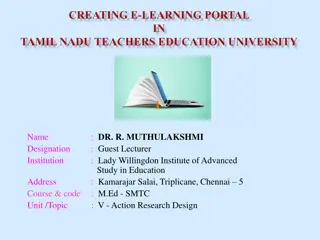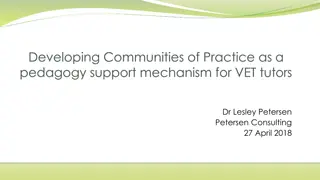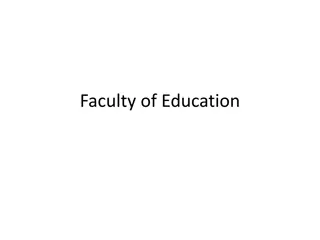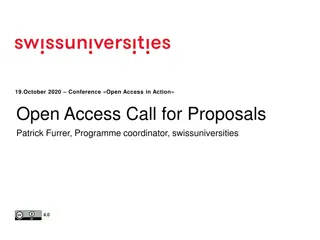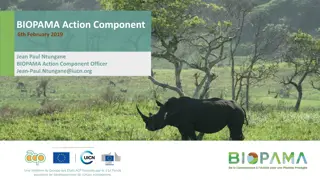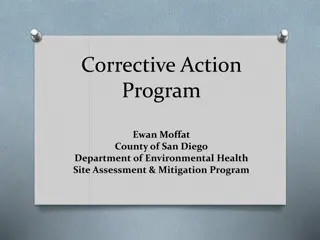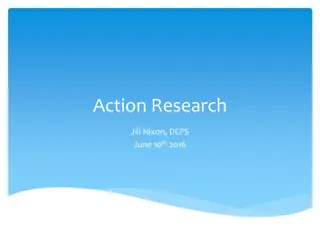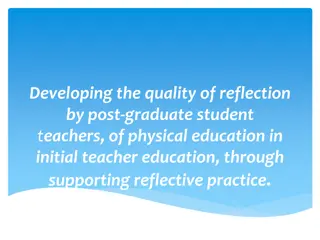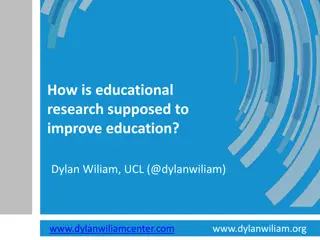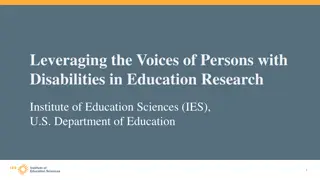Action Research: Enhancing Education Practices
Action research is a popular approach in education that encourages practitioners to conduct research to improve teaching and learning. It involves applying scientific thinking to real-life problems for better decision-making and actions, benefiting teachers and administrators. Goals include identifying and implementing strategies to address school-related issues and fostering a cooperative and democratic learning environment.
Download Presentation

Please find below an Image/Link to download the presentation.
The content on the website is provided AS IS for your information and personal use only. It may not be sold, licensed, or shared on other websites without obtaining consent from the author. Download presentation by click this link. If you encounter any issues during the download, it is possible that the publisher has removed the file from their server.
E N D
Presentation Transcript
: DR. R. MUTHULAKSHMI : Guest Lecturer : Lady Willingdon Institute ofAdvanced Study in Education : Kamarajar Salai, Triplicane, Chennai 5 : M.Ed - SMTC : V -Action Research Design Name Designation Institution Address Course & code Unit /Topic
Contents Meaning Purpose Types Key Characteristics Steps
The term action research was first coined by Kurt Lewin in 1944. Action research is very popular in the field of education to meet the requirement and further progress for effective teaching and learning. The approach of action research emphasizes encouragement to the practitioners namely teachers, administrators and academicians to do research in order to improve their own fields.
Meaning ofAction Research Action research is a scientific research used generally to solve problems in day-to-day classroom activities practically through systematic actions. Definition ofAction Research On the spot research aimed at the solution of an immediate problem is generally known in education as action research . - Mouly
Action Research is the application of scientific thinking to real life problems and represents a great improvement over teacher s subjective judgement and their limited personal experiences. - Kurt Lewin Action Research is a research used by teachers, supervisors and administrators to improve the quality of their decisions and actions. - Good
Goals and Objectives of Action Research To address the relevant problem related to school environment To find the possible solutions and follow up actions . To identify and utilize the appropriate strategies
Purpose of Action Research To improve the practices going on in the schools To remove the notion that educational research is the job of specialists only . To make teachers and the educational administrators research- minded. To make the school or educational personnel more cooperative and democratic in their work. To make the environment of the school more conducive for effective teaching and learning. To provide guidelines to solve immediate problems. To establish feedback and follow up mechanism
Need and Significance ofAction Research Action research provides systematic study of the problem. It dispels the fear and confirms that action research is doing for the people who needs remedies. It helps to find objective way of teaching and learning It creates awareness among the teachers and administrators about school related problems. It helps to improve the quality in teaching and learning process. It helps to address the day-to-day issues related to classroom environment. It is a sort of cooperative endeavors which involve teaching and non-teaching teams.
Types of Action Research Designs There are different types of action research according to the relevance of the problem. The common types of action research are as follows, Individual action research design Collaborative action research design School-wide action research design District-wide action research design
Individual action research design Individual action research is a research conducted by one person from the particular domain. This type of research is conducted to analyze and find solution to a specific task or problem. Example (classroom) Problem: A study to find the effectiveness of using peer group learning in English Classroom Action: *. One teacher performs by implementing strategies such as equalizing peer groups, identifying strength and weakness, allotting time, giving instruction followed by activities. *. After the action, the teacher analyses the results and find whether the peer group involvement improves learning or not in English classroom.
Collaborative action research design Collaborative action research is a research that involves group work more than one people engaged to analyze the new task which is given to a group of students. Example Problem: A study to find the impact in conducting the online objective test on sixth standard students Action: *. Head Master, administrators and teachers who are handling sixth standard involves in implementing the online objective test by using online platform that has to be proper usage of technology and identifying the level of interest of the students *. After implementing the program the results are analyzed by them and find whether online platform possible to conduct objective test for sixth standard students.
School -wide action research design Generally the scope of action research is vital in school environment to find a problem associated with an entire school. School-wide action research is a research conducted by staffs together to study the problem. Example Problem: A study to find the cooperation between parents and teachers. Action: *. The staff, parents and higher authority of Parent- teacher association works together by analyzing the problem includes adequate meeting, funds, students performance. *. After the action they decides how to correct the problem using proper discussion.
District-wide action research design District-wide action research is a research conducted for an entire school district to address the organizational problems within the district and it comes in community based research. Example Problem: A study to address the issues related to district level sports competition. Action : *. Relevant staff from each school involves in finding the issues related to how to select the students, funds, getting permission from district collector and transport *. After addressing the issues they works together in finding the ways to improve the positive climate among their organizations.
Key Characteristics of Action Research It is a dynamic, objective and cyclic process Active engagement is possible Adopting scientific steps is relevant It is a collaborative process It uses the techniques of research systematically Application oriented action is involved The academician and researcher s own practices is applied It establishes positive administrators , students and academicians. It has continuous evaluation It enhances new ideas to examine in actions It is a short term researcher process. rapport between teachers,
Steps in conducting Action Research The following necessary steps can be carried out to do action research. Identification of the problem Follow- up and Communicating the findings to others Listing the probable causes of the problem Action Research Cycle Evaluation of the action programme Analyze the causes and formulation of action hypothesis Action Programme
Step 1 Identification of the problem The problem should be properly defined, classified and verified so that an appropriate strategies can be applied. Practicability and feasibility to identify the problem is to be considered. Example: The problem inside the school environment is flexible for the school teacher. *. To find the reason why students are making noise when the teacher teaching grammar. Step 2 Listing the probable causes of the problem The discussion may be held with experts form various domains to study the causes inside the problem and properly listed.
Example: To find the reason, why students are making noise when the teacher teaching grammar. The possible causes for the above problem may be as follows, afraid of second language illiterate parents lack of regular practice lack of interest in doing grammar exercise Steps- 3 Analyze the causes and formulation of action hypothesis Action hypothesis is framed based on the relevant causes related to the nature of the problem. Example Action Hypothesis: Problem of making noise in English grammar class can be solved by individual participation in doing grammar exercise and proper correction of exercise everyday.
Step 4 Action Programme Here, the action is taken based on the framed hypothesis which includes duration of time period, action to be taken and proper procedures and tools applied. The action programmes will be giving exercise related to life experiences, Testing strategies, peer group learning and proper correction. Example: action Duration of period Action to be taken Procedure and tools applied Observe the students and testing the basic knowledge English dictation. First three days Identify performer in doing grammar exercise the low in using
Step 5 Evaluation of the action programme After the action programme the evaluation process is taken using appropriate techniques to know whether the action programme enhances the students performance and whether the framed hypothesis will be established or rejected. Example: Regular correction is to be done by the teacher to know the engagement and performance of the students in doing grammar exercise.
Step - 6 Follow-up and communicating the findings to others. Follow-up is an essential stage to bring improvements in the performance of the students and continuously monitored by the teacher to avoid the mistakes. Desirable results has to be communicated by the teacher to others in order to reduce the learning difficulties. Example: For the chosen action research problem, the follow-up programme are as follows, The performance of the students will be verified in frequent time interval Individual attention and positive reinforcement will be taken appreciation of the desirable results with others helps to reduce undesirable behaviour in the classroom.
I - Personal data Name of the investigator. Address of the investigator. Qualification of the investigator. Class and subject taught. II- Action research plan Introduction. Objectives. Research hypothesis. Target group. Tool. Procedure. Data analysis. Time required and time scheduled. Budget estimate. A. B. C. D. E. F. G. H. I.
II. A. Introduction Beginning part of the proposal. Give the brief write-up on the background and statement of the problem. Give the rationale for concluding the research. Example: Mapping is not done properly by the students . Rationale: why should I study? B. Objectives State the objectives of the proposal research which researcher would like to realize. Example: To gain knowledge about the area of the map. To understand the meaning of the different symbols used in the map. To analyze the colour differences marked in the map.
C. Research hypothesis Formulate objectives Example: If the teacher educators teach about demonstrate it practically, the pupil teacher will acquire knowledge, skill and inspiration for making use of the demonstration in their practice teaching. D. Target group Mention the number of people for whom the research is going to be conducted. So give information about age, class, sex and subject. Example: VI std, female, Science students. certain research hypothesis based on the
E. Tools Use teacher made or standardized tools like questionnaire, schedule, rating scale etc.., with proper description of the tools. Example: Self concept questionnaire prepared by Dr. T. Lizzy which contains 30 items of yes or no types. If yes means give 1 mark for positive questions. If no means give 1 mark for negative questions. F. Procedure Write about the systematic application which is going to be followed in the collection of data including statistical techniques. Example: Investigator distribute the questions to the students with proper instruction about the time limit, how to put the tick mark etc..,
G. Data analysis Investigator has to point out the qualitative and quantitative analysis. H. Time required and time scheduled Prepare a time schedule for conducting the research beginning and ending date of the research. I. Budget estimation Mention the approximate expenditure that would be incurred for carrying out the research like stationary, clerical assistance, teaching learning materials, data collection, report writing etc..,
Significance of action research in teacher education Improving teachers own teaching. Brings the desired modifications in the behavior of their pupils. Bring improvement in the performance of the task or duties. Dispels the fear of solving their problems. Gives them opportunity to test their beliefs and to take advantages of their own experiences. Improves the quality of teaching learning process without extra financial expenditure. Gives birth to cooperative feeling and develops mutual understand. Reduces wastage and stagnation in the teaching learning process.
Summary of Action Research Action research is a scientific process that includes problem investigations, action process, finding results and follow-up process. The principles of action research are applied in teaching and learning environment to solve the problems inside itself. It is a valuable resource for the teachers to develop their knowledge and experience in research field and this environment enables the teachers and other stakeholders to identify new educational problems. It is a continuous process that help the teachers to engage in systematic inquiry among the students in order to craft them as a high achiever. Hence it can be concluded that, Perfection in action leads to promote desirable accomplishments in all domains .
References Best, W. John., and Kahn, V. James. (1996). Research in Education (Seventh Edition). Prentice-Hall of India. Gupta, S. K., and Rangi, P. (2014). Research Methodology: Methods, Tools and Technique. Kalyani publishers. Kothari, C.P. (2014). Research Methodology Methods and Techniques (Third Edition). Publishers. Leedy and Ormrod. (2005). Action Research for Educational Change. Milton Keynes: Open University Press. Mangal, S.K. (1995). Educational Psychology. Prakash Publishers. Mohan Radha. (2011). Research Methods in Education. Neelkamal Publications. Nagarajan, K., and Srinivasan, Methodology in Education. Ram Publication. Singh, A.K. (1997). Tests, Measurements and Research Methods in Behavioural Sciences. Bharati Bhawan. New Age International R. (1994). Research











